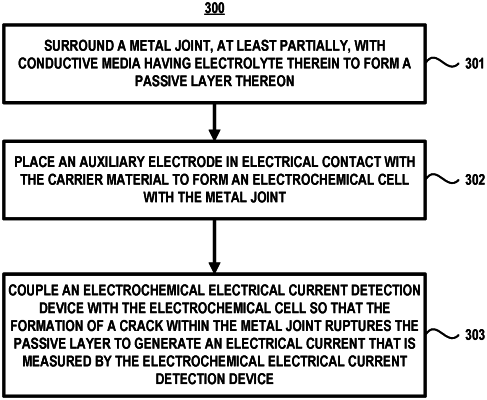| CPC G01M 5/0033 (2013.01) [G01N 27/30 (2013.01)] | 20 Claims |

|
1. A method for detecting the formation of a crack in a metal joint having an iron alloy comprising the steps of:
surrounding the metal joint, at least partially, with carrier material selected from the group consisting of paste and concrete with the carrier material having electrolyte therein,
placing an auxiliary electrode having a predetermined metal in electrical contact with the carrier material to create a passive layer on a galvanized coating and to form an electrochemical cell with the metal joint,
coupling an electrochemical electrical current detection device with the electrochemical cell so that the formation of a crack within the metal joint ruptures the passive layer to generate an electrical current that is measured by the electrochemical electrical current detection device,
converting the electric current into a digital signal, and
sending the digital signal to a mobile device.
|
|
11. A method for detecting a fatigue toe crack in a metal pole assembly, wherein the metal pole assembly includes a pole, a base plate, and a connection between the pole and the base plate, the method including the steps of:
surrounding the connection, at least partially, with carrier material selected from the group consisting of paste and concrete with the carrier material having electrolyte therein,
placing an auxiliary electrode having a predetermined metal in electrical contact with the carrier material to create a passive layer on a galvanized coating and to form an electrochemical cell with the metal pole assembly,
coupling an electrochemical electrical current detection device with the electrochemical cell so that the formation of a crack within the connection ruptures the passive layer to generate an electrical current that is measured by the electrochemical electrical current detection device,
converting the electric current into a digital signal, and
sending the digital signal to a mobile device.
|